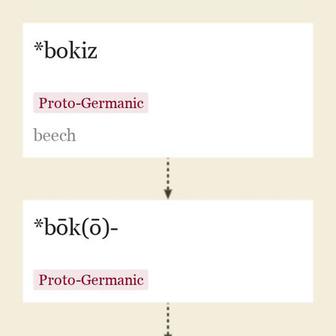bookcase (n.)
同时也有 book-case,意为“用于存放书籍的架子”,始见于1726年,由 book(书籍)和 case(箱子)组成。古英语中用于表示此意的词汇为 bocfodder。
bookcase 的相关词汇

中古英语 bok,源自古英语 boc “书,写作,书面文件”,通常指代(尽管存在语音困难)原始日耳曼语 *bōk(ō)-,源自 *bokiz “山毛榉”(源头还包括德语 Buch “书”和 Buche “山毛榉”; 参见 beech),意思是山毛榉木板上刻有符文; 但也可能来自山毛榉树本身(人们仍然在上面刻下自己的名字缩写)。
拉丁语和梵语也有以树木名称为基础的“写作”单词(分别是“桦树”和“灰树”)。并且比较一下法语 livre “书”,源自拉丁语 librum,最初是指“树皮”(参见 library)。
这个意思在早期中古英语时逐渐缩小为“一个由许多页面组成的书面作品,被固定在一起并装订”,也可以是任何形式的“文学作品”,无论有多少卷。后来也包括“装订的页面”,无论是否有文字。在19世纪,它也可以指“杂志”; 在20世纪,它是电话簿。
The use of books or written charters was introduced in Anglo-Saxon times by the ecclesiastics, as affording more permanent and satisfactory evidence of a grant or conveyance of land than the symbolical or actual delivery of possession before witnesses, which was the method then in vogue. [Century Dictionary]
书或书面特许证书的使用是由教士在盎格鲁-撒克逊时期引入的,因为它提供了比当时流行的在见证人面前象征性或实际交付财产的证据更为持久和令人满意的证据。[世纪词典]
从公元1200年开始,“更大作品的主要分部”。意思是“歌剧的歌词”来自1768年。下注 book “下注记录”来自1812年。意思是“犯罪指控总数”来自1926年,因此俚语短语 throw the book at(1932年)。Book of Life “被选为永生的人名单”来自14世纪中期。Book of the month 来自1926年。按照规则做某事 by the book 来自1590年代。
“容器,盒子,包含或装载物品的东西”,早在14世纪,源自盎格鲁-法语和古北法语 casse(古法语 chasse “盒子,圣骨箱”; 现代法语 châsse),来自拉丁语 capsa “盒子,贮藏室”(特别是放书的地方),源自 capere “拿,持”(源自 PIE 词根 *kap- “抓住”)。
“外在的保护覆盖物”的意思来自于14世纪晚期。此外,在1660年代也有“框架”的意思(如 staircase, casement)。火炮的意思来自1660年代,来自 case-shot “装在盒子里的小弹丸”(1620年代)。在印刷业中的应用(最早记录于1580年代)指的是排版工将字母放入不同大小的隔板中便于取用的两个浅木盘,这导致了 upper-case 用于大写字母(1862年),因为它在排版工倾斜的工作桌上的高位置,以及 lower-case 用于小写字母。
The cases, or receptacles, for the type, which are always in pairs, and termed the 'upper' and the 'lower,' are formed of two oblong wooden frames, divided into compartments or boxes of different dimensions, the upper case containing ninety-eight and the lower fifty-four. In the upper case are placed the capital, small capital, and accented letters, also figures, signs for reference to notes &c.; in the lower case the ordinary running letter, points for punctuation, spaces for separating the words, and quadrats for filling up the short lines. [The Literary Gazette, Jan. 29, 1859]
“盛放排版字模的盒子或容器,总是成对出现,分别称为'上盘'和'下盘',由两个长方形的木框组成,分成不同大小的隔板或盒子,上盘包含98个,下盘包含54个。上盘中放置大写字母、小大写字母和有重音符号的字母,还有数字、注释等标志; 下盘中放置普通的小写字母、标点符号、单词之间的空格和填充短行的四分之一空格。” [《文学公报》,1859年1月29日]